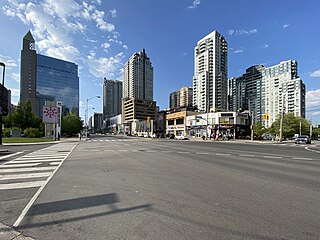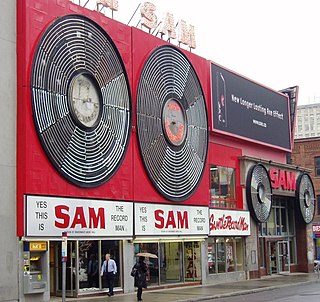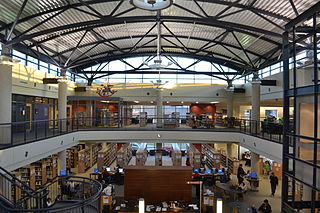
Hudson's Bay, also known as The Bay, is a Canadian luxury goods department store chain. It is the flagship brand of the Hudson's Bay Company (HBC), the oldest and longest-surviving company in North America as well as one of the oldest and largest continuously operating companies in the world.

Yonge Street is a major arterial route in the Canadian province of Ontario connecting the shores of Lake Ontario in Toronto to Lake Simcoe, a gateway to the Upper Great Lakes. Ontario's first colonial administrator, John Graves Simcoe, named the street for his friend Sir George Yonge, an expert on ancient Roman roads.

The Toronto Eaton Centre is a shopping mall and office complex in the downtown core of Toronto, Ontario, Canada. It is owned and managed by Cadillac Fairview (CF). It was named after the Eaton's department store chain that once anchored it before the chain went defunct in the late 1990s.

North York City Centre is a central business district in Toronto, Ontario, Canada in the administrative district of North York. It is located along Yonge Street, between just south of Sheppard Avenue northward to Finch Avenue with its focus around Mel Lastman Square, a civic square, and spreads eastwards and westwards a few blocks, generally as far as Doris Avenue and Beecroft Road. The district is a high-density district of condominium and office towers with ground-floor commercial uses along the wide six lanes of Yonge Street.

The Art Gallery of Ontario is an art museum in Toronto, Ontario, Canada, located in the Grange Park neighbourhood of downtown Toronto, on Dundas Street West. The building complex takes up 45,000 square metres (480,000 sq ft) of physical space, making it one of the largest art museums in North America and the second-largest art museum in Toronto, after the Royal Ontario Museum. In addition to exhibition spaces, the museum also houses an artist-in-residence office and studio, dining facilities, event spaces, gift shop, library and archives, theatre and lecture hall, research centre, and a workshop.

Seneca College of Applied Arts and Technology, operating as Seneca Polytechnic from 2023, is a multiple-campus public college in the Greater Toronto Area, and Peterborough, Ontario, Canada regions. It offers full-time and part-time programs at the baccalaureate, diploma, certificate, and graduate levels attended primarily by international students from whom it draws 80% of its tuition revenue. Seneca College had Canada's largest enrolment of 9,318 international students in 2020-21.

The Bata Shoe Museum (BSM) is a museum of footwear and calceology in Toronto, Ontario, Canada. The museum's building is situated near the northwest of the University of Toronto's St. George campus, in downtown Toronto. The 3,665-square-metre (39,450 sq ft) museum building was designed by Moriyama & Teshima Architects, with Raymond Moriyama as the lead architect.

Massey Hall is a performing arts theatre in Toronto, Ontario, Canada. Opened in 1894, it is known for its outstanding acoustics and was the long-time hall of the Toronto Symphony Orchestra. An intimate theatre, it was originally designed to seat 3,500 patrons, but after extensive renovations in the 1940s, it now seats up to 2,765. It has an extensive history of concerts by artists of many musical genres which continues today.

The Church of the Holy Trinity is an Anglican church located at Trinity Square in Toronto, Ontario, Canada.

Union is a subway station on Line 1 Yonge–University of the Toronto subway in Toronto, Ontario, Canada. It opened in 1954 as one of twelve original stations on the first phase of the Yonge line, the first rapid transit line in Canada. It was the southern terminus of the line until the opening of the University line in 1963, and is today the inflection point of the U-shaped line. Along with Spadina station, it is one of two stations open overnight to support late-night streetcar routes.

Sam the Record Man was a Canadian record store chain that, at one time, was Canada's largest music recording retailer. In 1982, its ads proclaimed that it had "140 locations, coast to coast".

Commerce Court is an office building complex on King and Bay Streets in the financial district of Toronto, Ontario, Canada. The four-building complex is a mix of Art Deco, International, and early Modernism architectural styles. The office complex served as the corporate headquarters for the Canadian Imperial Bank of Commerce (CIBC) and its predecessor, the Canadian Bank of Commerce, from 1931 to 2021. Although CIBC relocated its headquarters to CIBC Square, the bank still maintains offices at Commerce Court.

Toronto Public Library is a public library system in Toronto, Ontario. It is the largest public library system in Canada, and in 2008 had averaged a higher circulation per capita than any other public library system internationally, making it the largest neighbourhood-based library system in the world. Within North America, it also had the highest circulation and visitors when compared to other large urban systems. Established as the library of the Mechanics' Institute in 1830, the Toronto Public Library now consists of 100 branch libraries and has over 12 million items in its collection.

North York Central Library is a Toronto Public Library branch located in North York City Centre, Toronto, Ontario, Canada. It is one of the two libraries in Toronto considered to be "Research and Reference Libraries", the other being the Toronto Reference Library in the city's downtown core. In contrast to the Toronto Reference Library, however, most of the items in the North York Central Library can be signed out.

Raymond Junichi Moriyama was a Canadian architect.

The Garden District is a neighbourhood in downtown Toronto, Ontario, Canada. The name was selected by the Toronto East Downtown Residents Association (TEDRA) in recognition of Allan Gardens, an indoor botanical garden located nearby at the intersection of Carlton and Jarvis Streets. The Garden District was officially designated by the Mayor and Toronto City Council in 2001, while TEDRA has since been renamed the Garden District Residents Association. Part of the neighbourhood is within official City of Toronto neighbourhood of Moss Park.

The Aurora Public Library is located in Aurora, Ontario, Canada. The library has a collection of more than 150,000 items and has over 31,000 registered users.

The George R. Gardiner Museum of Ceramic Art is a ceramics museum in Toronto, Ontario, Canada. The museum is situated within University of Toronto's St. George campus, in downtown Toronto. The 4,299.2-square-metre (46,276 sq ft) museum building was designed by Keith Wagland, with further expansions and renovations done by KPMB Architects.

The Koffler Student Centre is the main student centre at the University of Toronto, located at 214 College Street. The centre houses a number of different student services, including the main campus bookstore, career centre, and health clinic. The ornate building is located at the northwest corner of St. George and College Street streets in a building that was formerly the home of the Toronto Reference Library.

Toronto Metropolitan University is a public research university located in Toronto, Ontario, Canada. The university's core campus is situated within the Garden District, although it also operates facilities elsewhere in Toronto. The university operates seven academic divisions/faculties, the Faculty of Arts, the Faculty of Community Services, the Faculty of Engineering and Architectural Science, the Faculty of Science, The Creative School, the Lincoln Alexander School of Law, and the Ted Rogers School of Management. Many of these faculties are further organized into smaller departments and schools. The university also provides continuing education services through the G. Raymond Chang School of Continuing Education.



























